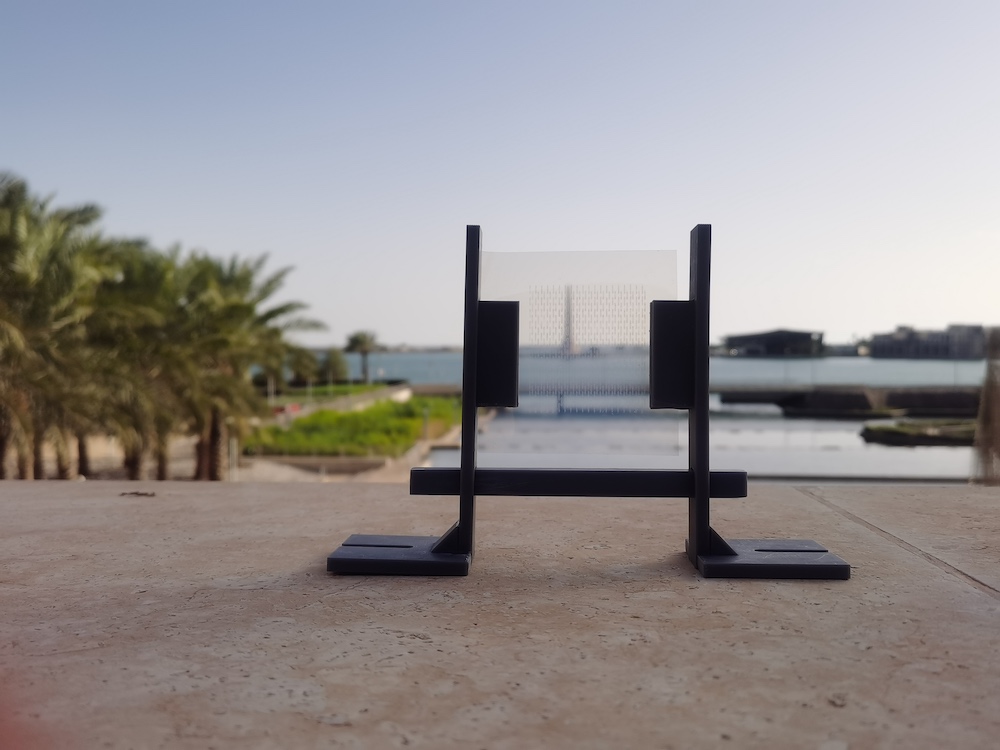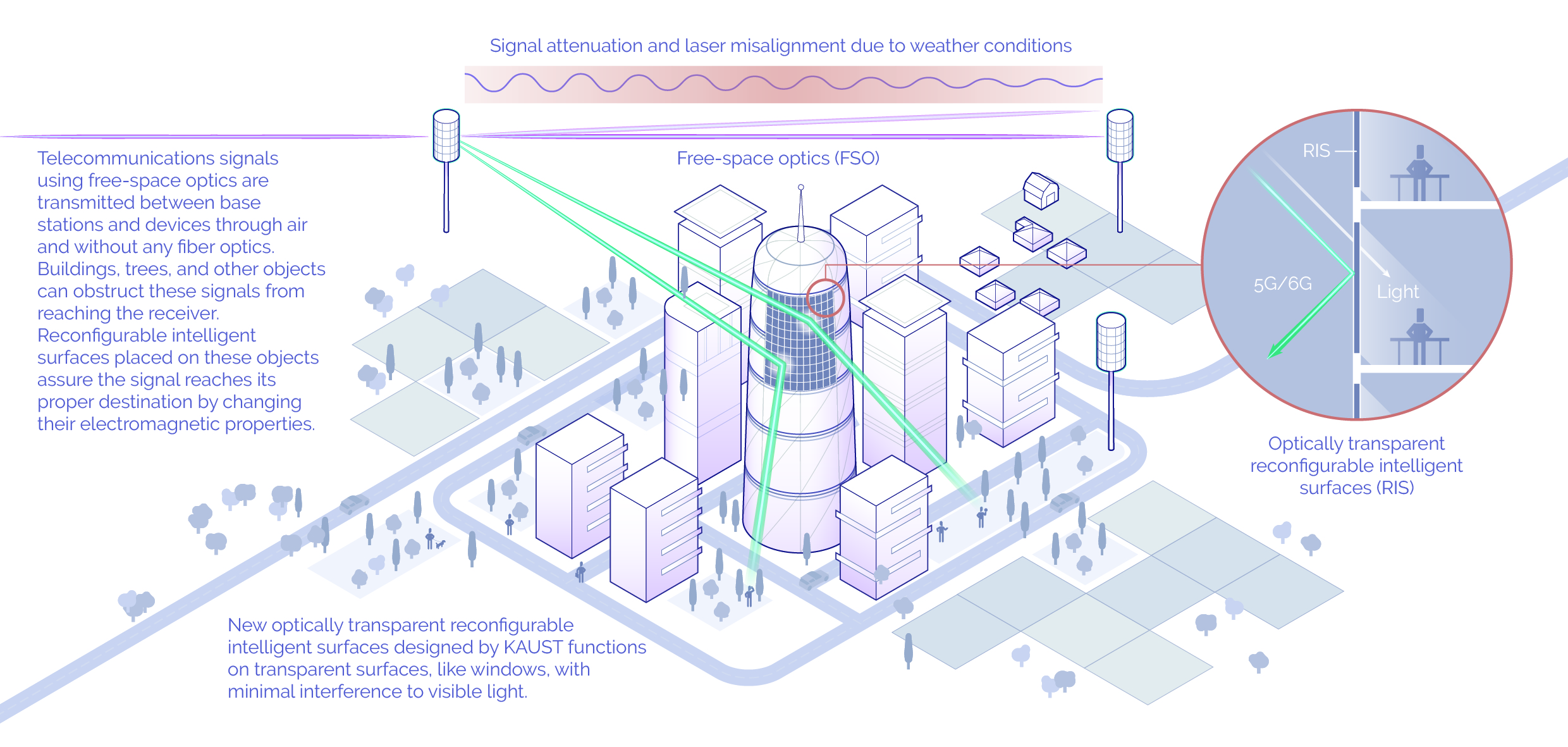KAUST pushes Saudi to forefront of 6G technologies

A view of the KAUST Beacon through KAUST’s optically transparent RIS.
More than 50 billion devices will be online by 2025. These include those that control electric grids for cities to the ones in your hand for scrolling social media. This number and the amount of data they transmit were impossible even ten years ago. The difference between then and now is telecommunications technologies. 5G (fifth generation telecommunications) and soon 6G are making gigabytes of data available at the press of a button just about anywhere in the world.
While telecommunications companies can invest in their own research and development to innovate 5G and 6G technologies, a more reliable model has them partner with universities. For Ericsson, the multinational telecommunications company based in Sweden, KAUST is that university.
Earlier this year, Ericsson announced that it was continuing its funding for two telecommunications programs at KAUST. The first, managed by KAUST Professor Mohamed-Slim Alouini, is investigating free-space optics (FSO), and the other, managed by his colleague Professor Atif Shamim, is developing reconfigurable intelligent surfaces (RIS); both technologies have been identified by industry as critical for achieving 5G and 6G.
“Our ongoing partnership with KAUST yielded significant advancements in telecommunication technologies, which have been crucial in pushing the boundaries of what's possible in the 5G and emerging 6G space. As we move into the next phase our focus will further revolutionize connectivity and telecommunication technologies,” said Mashhour Al-Sudairy, Head of Local Content at Ericsson Kingdom of Saudi Arabia.
The next generation of telecommunications
When a message between two devices, like smartphones, is sent, the signal from one phone normally does not go directly to the other. Instead, it is first received by a base station, which manages the signals for all wireless devices in a defined area. In the past, base stations would be connected by fiber optic cables, but this approach is not economical for 5G and 6G.
FSO describes communications in which a laser transmits a signal through free space (outer space, air) to a detector without a cable. FSO is not new technology; Alexander Graham Bell, the father of the first telephone, is attributed to have demonstrated it. However, it must overcome certain limitations before its widespread use for 5G and 6G.
"The problem is that it is perceived as unreliable. One reason is that it is very sensitive to weather conditions – fog, haze, rain, sandstorms,” explained Alouini. “As the signal passes through air, it attenuates so that the signal reaching the detector is weaker than that emitted by the transmitter.” Moreover, the attenuation increases with signals of higher frequency, and 6G has the highest frequency to date (at least 100 GHz).
The second reason is that it is difficult to maintain the alignment of the laser and receiver. This misalignment can occur through inevitable weather changes, such as the extreme temperature highs during the day and lows at night common in Saudi Arabia deserts, causing thermal expansion of the equipment.

Alouini is quantifying the degree of weather effects on the signal transmission. His project is building an exhaustive database of events in Saudi Arabia that answers why communication outages happen, how often they happen, and how long they happen. With this information, Ericsson and other companies can strategically place their bay stations and set up auxiliary systems for when they fail.
Smart surfaces for telecommunications
RIS provide another solution to the problem of signal loss. Buildings in urban areas often house base stations on their rooftops. However, these same buildings obstruct signals from other towers, deflecting them from their original pathway. RIS correct the deflection by acting like a mirror that redirects a signal around the obstacle except, unlike a mirror, which rotates its axis to change the angle of light, the physical angle of the RIS does not change. Instead, the array of cells constituting the RIS are electronically reconfigured.
These cells are not cheap, especially when considering one RIS is comprised of hundreds or even thousands of them. Each cell is typically constituted of metal, insulator and semiconductor layers, and its fabrication is done in a cleanroom, which is a laboratory environment that includes expensive equipment and other infrastructure and is operated by highly skilled and educated staff. Shamim has developed inks and printing processes that make the cleanroom unnecessary. The cell printing can be done in a standard scientific laboratory with basic equipment and less labour. Thus, the price of one cell drops from several dollars to under a dollar. The expected savings will go a long way to 6G accessibility, which is why his inks and printed RIS have attracted the attention of industry partners like Ericsson.
Another issue is installation. In principle, RIS can be placed anywhere on a building including concrete walls and glass windows. However, without optical transparency, the RIS will obstruct any light penetrating the windows. The solution is an RIS that can control the electromagnetic signals without affecting the window transparency.
“Installing RIS on windows is challenging. We need RIS that can control electromagnetic signals without affecting the light penetrating through them; however, most metals are opaque” explained Shamim.
For a new standard in RIS technology, Shamim’s group has come up with a metallic ink comprised of silver nanowires. This ink has set a world record for the combination of optical transparency and conductivity.
In the next phase of the Ericsson project, Shamim is examining how to extend his affordable manufacturing technologies to the higher frequencies needed for 6G.
“The knowledge we have gained from 5G about design and testing will go a long way towards 6G,” he said.
By testing novel FSO and RIS technologies in Saudi Arabia and collecting an unprecedented amount of data on Saudi weather conditions and communications performance, KAUST is positioning the Kingdom as a leader for 6G, attracting companies to invest and scientists to test their research.

